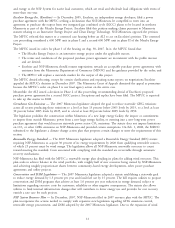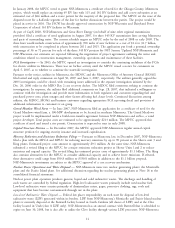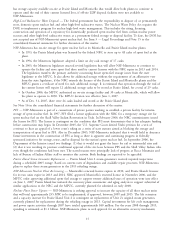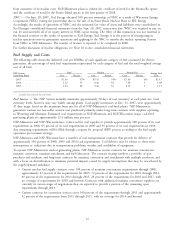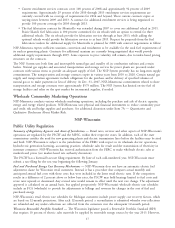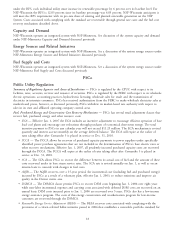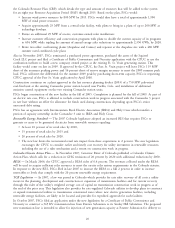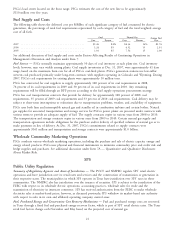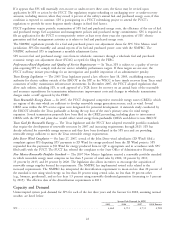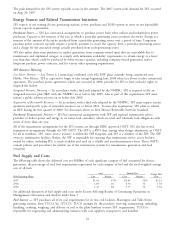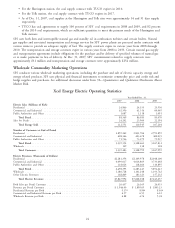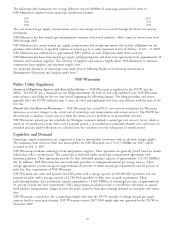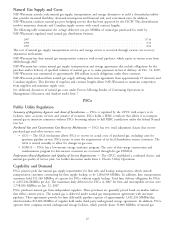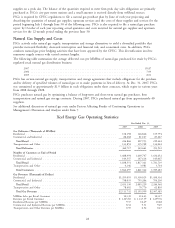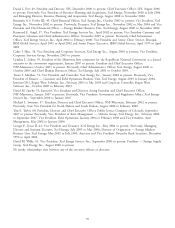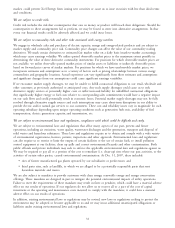Xcel Energy 2007 Annual Report Download - page 32
Download and view the complete annual report
Please find page 32 of the 2007 Xcel Energy annual report below. You can navigate through the pages in the report by either clicking on the pages listed below, or by using the keyword search tool below to find specific information within the annual report.
If it appears that SPS will materially over-recover or under-recover these costs, the factor may be revised upon
application by SPS or action by the PUCT. The regulations require refunding or surcharging over- or under-recovery
amounts, including interest, when they exceed 4 percent of the utility’s annual fuel and purchased energy costs, if this
condition is expected to continue. SPS is participating in a PUCT rulemaking project to amend the PUCT’s
regulations to provide for more frequent timely changes in fixed fuel factors.
PUCT regulations require periodic examination of SPS fuel and purchased energy costs, the efficiency of the use of fuel
and purchased energy, fuel acquisition and management policies and purchased energy commitments. SPS is required to
file an application for the PUCT to retrospectively review at least every three years the operations of SPS’ electric
generation and fuel management activities as it relates to fuel and purchased energy costs.
The NMPRC regulations provide for a fuel and purchased power cost adjustment clause for SPS’ New Mexico retail
jurisdiction. SPS files monthly and annual reports of its fuel and purchased power costs with the NMPRC. The
NMPRC authorized SPS to implement a monthly adjustment factor.
SPS recovers fuel and purchased energy costs from its wholesale customers through a wholesale fuel and purchased
economic energy cost adjustment clause (FCAC) accepted for filing by the FERC.
Performance-Based Regulation and Quality of Service Requirements — In Texas, SPS is subject to a quality of service
plan requiring SPS to comply with electric service reliability performance targets. If these targets are not met, the
PUCT staff may initiate proceedings for an investigation and possible imposition of an administrative penalty.
Texas Energy Legislation — The 2005 Texas legislature passed a law, effective June 18, 2005, establishing statutory
authority for electric utilities outside of the ERCOT in the SPP or the WECC to have timely recovery from Texas retail
consumers of utility transmission infrastructure investments. In December 2007, the PUCT adopted regulations that
allow such utilities, including SPS, to seek approval of a TCR factor for recovery on an annual basis of the reasonable
and necessary expenditures for transmission infrastructure improvement costs and changes in wholesale transmission
charges under a tariff approved by the FERC.
Texas Renewable Energy Zones— In 2007, the PUCT designated competitive renewable energy zones (CREZs), which
are regions of the state which are sufficient to develop renewable energy generation sources, such as wind. Several
CREZ areas within the SPS service region were designated for potential development. A statewide study conducted by
the ERCOT identifies the Texas panhandle as having the top four of the state’s primary areas for wind energy
expansion. Several transmission proposals have been filed in the CREZ proceeding, including plans to interconnect
CREZs with the SPP and plans that would collect wind energy from panhandle CREZs and deliver it into ERCOT.
Texas Goal for Renewable Energy — The Texas legislature and the PUCT have adopted renewable portfolio standards
that require the development of renewable resources by 2007 and increasing requirements through 2025. SPS has
already solicited for renewable energy resources and they have been developed in the SPS area and are providing
renewable energy sufficient to meet the Texas renewable energy requirements.
John Deere Wind Complaint — On June 27, 2007, several of the John Deere wind subsidiaries (JD Wind) filed a
complaint against SPS disputing SPS’ payments to JD Wind for energy produced from the JD Wind projects. SPS
responded that the payments to JD Wind for energy produced from its QF is appropriate and in accordance with SPS’
filed tariffs with the PUCT. The PUCT has referred the complaint to the State Office of Administrative Hearings.
New Mexico Renewable Portfolio Standard — The 2007 New Mexico legislature enacted a renewable portfolio standard
in which renewable energy must comprise no less than 5 percent of retail sales by 2006; 10 percent by 2011;
15 percent by 2015; and 20 percent by 2020. The legislation also allows incentives to encourage the acquisition of
renewable energy supplies beyond the requirements. The NMPRC has implemented revised rules related to the
increased requirements. The NMPRC has interpreted the diversification requirement to mean no less than 20 percent of
the standard is met using wind energy, no less than 20 percent using central solar, no less than 10 percent other
(e.g., biomass, geothermal), and no less than 1.5 percent using renewable distributed generation (increasing to 3 percent
by 2015). The effective date of the diversification requirements is 2011.
Capacity and Demand
Uninterrupted system peak demand for SPS for each of the last three years and the forecast for 2008, assuming normal
weather, are listed below.
System Peak Demand (in MW)
2005 2006 2007 2008 Forecast
SPS................................................ 4,660 4,711 4,731 4,908
22


